最新科技英语翻译和写作
- 格式:ppt
- 大小:1.11 MB
- 文档页数:62
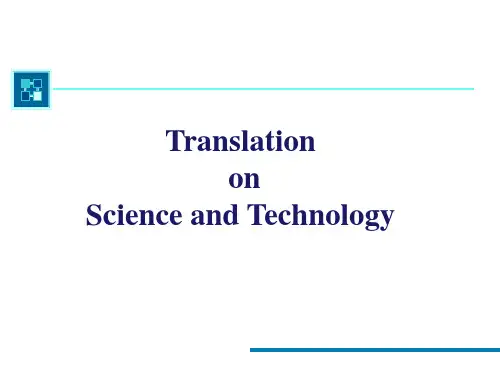

Unit 1Artificial intelligence is the science and engineering of making intelligent machines,especially intelligent computer programs.人工智能是制造智能机器的科学与工程,特别是智能化的计算机程序。
It is related to the similar task of using computers to understand human intelligence,but AI does not have to confine itself to methods that are biologically observable.这与使用计算机来理解人类智能的类似任务有关,但是人工智能不需要把它局限在生物可观察的方法上。
In this unit,the two passages present a general picture of AI research .在这个单元,两个章节提出了人工智能研究的概况。
Text A briefly introduces the definition of AI,some kinds of architectures of AI system,essential capabilities to AI programs and so on.文章A简要介绍了人工智能的定义,人工智能的系统的几种体系结构、基本功能以及程序等等。
Text B explains a particular area of AI research--natural language processing including its definition and a legendary Turing’s Test.文章A解释特定地区研究人工智能的自然语言处理包括定义和传说中的图灵测试。
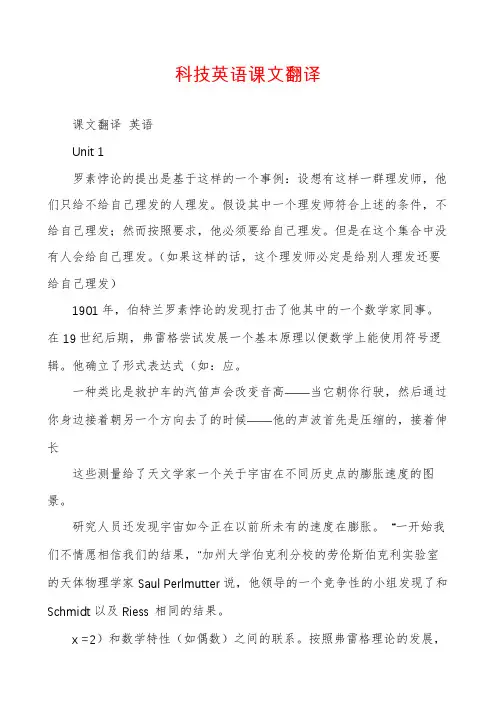
科技英语课文翻译课文翻译英语Unit 1罗素悖论的提出是基于这样的一个事例:设想有这样一群理发师,他们只给不给自己理发的人理发。
假设其中一个理发师符合上述的条件,不给自己理发;然而按照要求,他必须要给自己理发。
但是在这个集合中没有人会给自己理发。
(如果这样的话,这个理发师必定是给别人理发还要给自己理发)1901年,伯特兰罗素悖论的发现打击了他其中的一个数学家同事。
在19世纪后期,弗雷格尝试发展一个基本原理以便数学上能使用符号逻辑。
他确立了形式表达式(如:应。
一种类比是救护车的汽笛声会改变音高――当它朝你行驶,然后通过你身边接着朝另一个方向去了的时候――他的声波首先是压缩的,接着伸长这些测量给了天文学家一个关于宇宙在不同历史点的膨胀速度的图景。
研究人员还发现宇宙如今正在以前所未有的速度在膨胀。
“一开始我们不情愿相信我们的结果,”加州大学伯克利分校的劳伦斯伯克利实验室的天体物理学家Saul Perlmutter说,他领导的一个竞争性的小组发现了和Schmidt以及Riess 相同的结果。
x =2)和数学特性(如偶数)之间的联系。
按照弗雷格理论的发展,我们能自由的用一个特性去定义更多更深远的特性。
1903年,发表在《数学原理》上的罗素悖论从根本上揭示了弗雷格这种集合系统的局限性。
型的集合系统能很好的用俗称集的结构式来描述。
就现在而言,这种类们可以用x代表整数,通过n来表示并且n大于3例如,小于我7,来表示x={n4,5,6这样一个集合。
这种集合的书写形势就是:我们也可让:n是整数,y={x:3n7}x是美国的一个男性居民。
集合中的对象并不一定是数字。
}。
求的空间。
但是,罗素(和策梅洛一起)发现表面上看,似乎任何一个关于x的描述都有一个符合要a中}导致一个矛盾,就像对一群理发师的描述一样。
x={a:xa它本不再身是在x有致命的打击。
尽管这样,他还不能解决这个问题当罗素发现了悖论,的集合中吗?否定的答案导致了矛盾的出现。

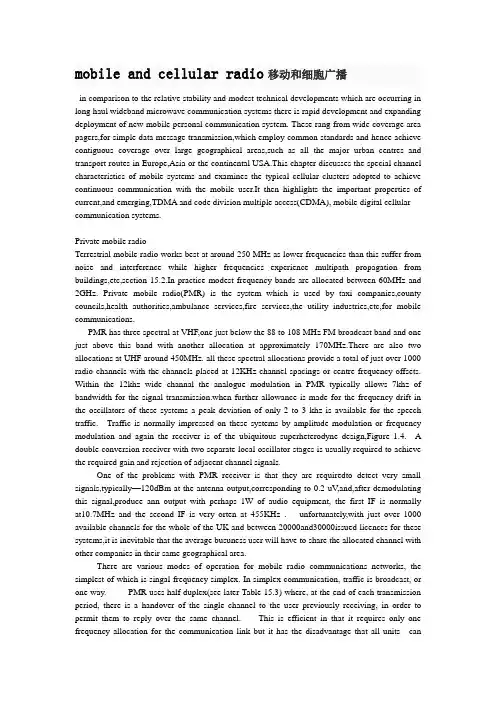
mobile and cellular radio移动和细胞广播in comparison to the relative stability and modest technical developments which are occurring in long haul wideband microwave communication systems there is rapid development and expanding deployment of new mobile personal communication system. These rang from wide coverage area pagers,for simple data message transmission,which employ common standards and hence achieve contiguous coverage over large geographical areas,such as all the major urban centres and transport routes in Europe,Asia or the continental USA.This chapter discusses the special channel characteristics of mobile systems and examines the typical cellular clusters adopted to achieve continuous communication with the mobile user.It then highlights the important properties of current,and emerging,TDMA and code division multiple access(CDMA), mobile digital cellular communication systems.Private mobile radioTerrestrial mobile radio works best at around 250 MHz as lower frequencies than this suffer from noise and interference while higher frequencies experience multipath propagation from buildings,etc,section 15.2.In practice modest frequency bands are allocated between 60MHz and 2GHz. Private mobile radio(PMR) is the system which is used by taxi companies,county councils,health authorities,ambulance services,fire services,the utility industries,etc,for mobile communications.PMR has three spectral at VHF,one just below the 88 to 108 MHz FM broadcast band and one just above this band with another allocation at approximately 170MHz.There are also two allocations at UHF around 450MHz. all these spectral allocations provide a total of just over 1000 radio channels with the channels placed at 12KHz channel spacings or centre frequency offsets. Within the 12khz wide channal the analogue modulation in PMR typically allows 7khz of bandwidth for the signal transmission.when further allowance is made for the frequency drift in the oscillators of these systems a peak deviation of only 2 to 3 khz is available for the speech traffic. Traffic is normally impressed on these systems by amplitude modulation or frequency modulation and again the receiver is of the ubiquitous superheterodyne design,Figure 1.4. A double conversion receiver with two separate local oscillator stages is usually required to achieve the required gain and rejection of adjacent channel signals.One of the problems with PMR receiver is that they are requiredto detect very small signals,typically—120dBm at the antenna output,corresponding to 0.2 uV,and,after demodulating this signal,produce ann output with perhaps 1W of audio equipment, the first IF is normally at10.7MHz and the second IF is very orten at 455KHz . unfortunately,with just over 1000 available channels for the whole of the UK and between 20000and30000issued licences for these systems,it is inevitable that the average busuness user will have to share the allocated channel with other companies in their same geographical area.There are various modes of operation for mobile radio communications networks, the simplest of which is singal frequency simplex. In simplex communication, traffic is broadcast, or one way. PMR uses half duplex(see later Table 15.3) where, at the end of each transmission period, there is a handover of the single channel to the user previously receiving, in order to permit them to reply over the same channel. This is efficient in that it requires only one frequency allocation for the communication link but it has the disadvantage that all units canhear all transmissions provided they are within rage of the mobile and frequencies are allocated for the transmissions. One frequency is used for the forward or downlink, namely base-to-mobile communications. This permits simultaneous two-way communication and greatly reduces the level of interference, but it halves other’s transmissions, which can lead to contention with two mobiles attempting to initiate a call, at the same time, on the uplink in a busy syetem.Although PMR employs relatively simple techniques with analogue speech transmission there have been many enhancements to these systems over the years . Data transmission is now in widespread use in PMR systems using FSK modulation. Data transmission also allows the possibility of hard copy graphics output and it gives direct access to computer services such as databases, etc. Data prembles can also be used, in a selective calling mode, when initiating a transmission to address a special receiver and thus obtain more privacy within the system.15.4.5 Trunked radio for paramilitary use集群无线电的军事使用Another related TDMA mobile radio standard is the European trunked radio(TETRA)network which has been developed as part of the public safety radio communications service(PSRCS) for use by police, utilities, customs office, etc. TETRA in fact is part of wider international collaborations for paramilitary radio use.In these portable radios there is a need for frequency hopping (FH) to give an antieavesdropping capability and encryption for security of transmission to extend military mobile radio capabilities to paramilitary use, i.e. for police, customs and excise offices, etc. these capabilities are included in the multiband interteam radio for the associated public safety communications office in the USA while Europe has adopted the TETRA standard.TETRA is essentially the digital TDMA replacement of the analogue PMR systems. The TETRA standard has spectrum allocations of 380 to 400 and 410 to 430MHz, with the lower band used for mobile transmissions and the upper band for base station use. TETRA mobile have 1 W output power and the base stations 25 W using error with the data throughput rate varying, to meet the required quality of service. TETRA can accommodate up to four users each with a basic speech or data rate of 7.2kbit/s. with coding and signaling overheads, the final transmission rate for the four-user slot is 36 kbit/s. this equipment is large and more sophisticated than a commercial cell phone, and it sells for a very much higher price becase the production runs are much small. However, its advanced capabilities are essential for achieving paramilitary communications which are secure from eavesdropping.15.5 Code division multiple accessAnalogue communication systems predominantly adopt frequency division multiple access (FDMA), where each subscriber is allocated a narrow frequency slot within the available channel. The alternative TDMA(GSM) technique allocates the entire channel bandwidth to a subscriber but constrains the subscriber but constrains the subscriber to transmit only regular short bursts of wideband signal. Both these accessing techniques are well established for long haulterrestrial, satellite and mobile communications as they offer very good utilization of the available bandwidth.15.5.1The inflexibility of these coordinated accessing techniques has resulted in the development of new systems based on the uncoordinated spread spectrum concept. In these systems the bits of slow speed data traffic from each subscriber are deliberately multiplied by a high chip rate spreading code, forcing the low rate (narrowband data signal) to fill a wide channel bandwidth.15.7.2 3G systemsThe evolution of the third generation (3G)system began when the ITU produce the initial recommendations for a new universal mobile telecommunications system(UMTS)[www.] The 3G mobile radio service provides higher data rate services ,with a maximum data rate in excess of 2Mbit/s, but the achievable bit rate is linked to mobility. Multimedia applications encompass services such as voice, audio/video, graphics, data, Internet access and e-mail. These packet and circuit switched services have to be supported by the radio interface and the network subsystem.Several radio transmission technologies(RTT) were evaluated by the ITU and adopted into the new standard, IMT-2000. the European standardization body for 3G, the ETSI Special Mobile Group, agreed on a radio access scheme for 3G UMTS universal terrestrial radio access(UTRA) as an evolution of GSM. UTRA consists of two modes : frequency division duplex(FDD) where the uplink and downlink are transmitted on different frequencies; and time division duplex(TDD) where the uplink and downlink are time multiplexed onto the same carrier frequency. The agreement assigned the unpaired bands (i.e. for UTRA TDD ). TD-CDMA is a pure CDMA based system. Both modes of UTRA have been harmonised with respect to basic system parameters such as carrier spacing, chip rate and frame length to ensure the interworking of UTRA with GSM.The 3G proposal were predominantly based wideband CDMA(WCDMA) and a mix of FDD and TDD access techniques. WCDMA is favoured for 3G in poor propagation environments with a mix of high modest speed data traffic. It is generally accepted that CDMA is the preferred accesstechnique and, with the increase in the data rate, then the spreading modulation needs to increase to wideband transmission.WCDMA is based on 3.84Mchip/s spreading codes with spreading ratio, i.e. , K values, of 4-256 giving corresponging data ratas of 960-15 kbit/s. the upper FDD uplink band I from 1920-1980 MHz is paired with a 2110-2170 MHz downlink. In addition uplink bands II & III at 1850-1910 MHz and 1710-1785 MHz are also paired, respectively, with 1930-1990 MHz and 1805-1880 MHz allocations. the system is configured on a 10 ms frame with 15 individual slots to facilitate TDD as well as FDD transmissions. TDD is more flexible as time-slots can be dynamically reassigned to uplink and downlink functions, as required for asymmetric transfer of large files or video on demand traffic. 3G WCDMA systems use an adaptive multirate speech coder with encoded rates of 4.75-12.2 kbit/s. receivers commonly use the easily integrated direct conversion design, in place of the superheterodyne design . receiver sensitivities are typically -155dBm.The 3GPP2 standard aims to achieve a wide area mobile wireless packet switched capability with CDMA2000 1×EV DO revision A (sometimes called IS-856A). Here 1×refers to the single carrier 1.25 Mchip/s system. It achieves a 3.1 Mbit/s downlink and a delay sensitive services. The 3GPP standard has gone through many release with R4 in 2001 which introduced packet data services and R6 in 2005 to further increase the available data transmission rate . R6 pioneers the use of high-speed downlink packet access and multimedia broadcast multicast services which offer reduced delays and increased uplink data rates approaching 6 Mbit/s.In parallel with the European activities extensive work on 3G mobile radio was also performed in Japan. The Japanese standardisation body also chose WCDMA, so that the Japanese and European proposals for the FDD mode were already aligned closely. Very similar concepts have also been adopted by the North American standardization body.In order to work towards a global 3G mobile radio standard, the third generation partnership project(3GPP), consisting of members of the standardization bodies in Europe, the USA, Japan, Korea and China, was formed. It has merged the already well harmonized proposals of the regional standardization bodies to work on a common 3G international mobile radio standard, still called UTRA. The 3GPP Project 2(3GPP2), on the other hand, works towards a 3G mobile radio standard based on cdmaOne/IS-95 evolution, originally called CDMA2000.比起相对稳定、适度的技术发展是发生在宽带微波通信系统,有长期快速发展和扩大部署的新的移动个人通讯系统。
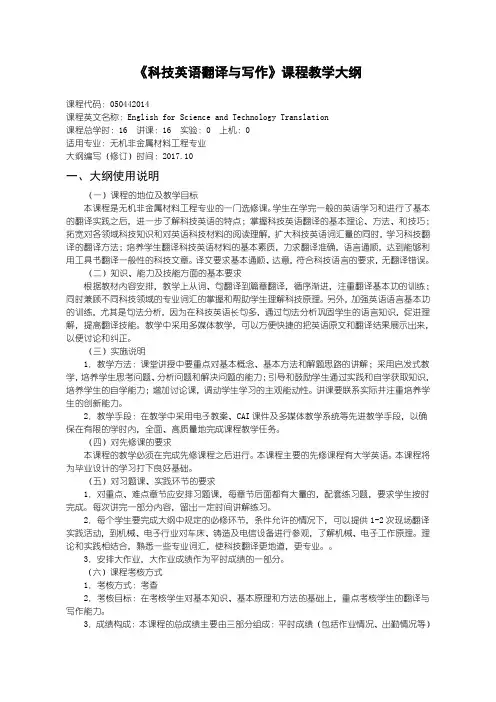
《科技英语翻译与写作》课程教学大纲课程代码:050442014课程英文名称:English for Science and Technology Translation课程总学时:16 讲课:16 实验:0 上机:0适用专业:无机非金属材料工程专业大纲编写(修订)时间:2017.10一、大纲使用说明(一)课程的地位及教学目标本课程是无机非金属材料工程专业的一门选修课。
学生在学完一般的英语学习和进行了基本的翻译实践之后,进一步了解科技英语的特点;掌握科技英语翻译的基本理论、方法、和技巧;拓宽对各领域科技知识和对英语科技材料的阅读理解,扩大科技英语词汇量的同时,学习科技翻译的翻译方法;培养学生翻译科技英语材料的基本素质,力求翻译准确,语言通顺,达到能够利用工具书翻译一般性的科技文章。
译文要求基本通顺、达意,符合科技语言的要求,无翻译错误。
(二)知识、能力及技能方面的基本要求根据教材内容安排,教学上从词、句翻译到篇章翻译,循序渐进,注重翻译基本功的训练;同时兼顾不同科技领域的专业词汇的掌握和帮助学生理解科技原理。
另外,加强英语语言基本功的训练,尤其是句法分析,因为在科技英语长句多,通过句法分析巩固学生的语言知识,促进理解,提高翻译技能。
教学中采用多媒体教学,可以方便快捷的把英语原文和翻译结果展示出来,以便讨论和纠正。
(三)实施说明1.教学方法:课堂讲授中要重点对基本概念、基本方法和解题思路的讲解;采用启发式教学,培养学生思考问题、分析问题和解决问题的能力;引导和鼓励学生通过实践和自学获取知识,培养学生的自学能力;增加讨论课,调动学生学习的主观能动性。
讲课要联系实际并注重培养学生的创新能力。
2.教学手段:在教学中采用电子教案、CAI课件及多媒体教学系统等先进教学手段,以确保在有限的学时内,全面、高质量地完成课程教学任务。
(四)对先修课的要求本课程的教学必须在完成先修课程之后进行。
本课程主要的先修课程有大学英语。
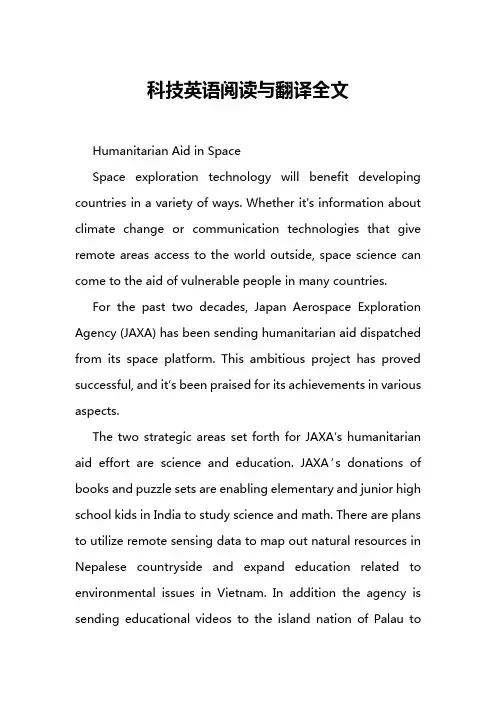
科技英语阅读与翻译全文Humanitarian Aid in SpaceSpace exploration technology will benefit developing countries in a variety of ways. Whether it's information about climate change or communication technologies that give remote areas access to the world outside, space science can come to the aid of vulnerable people in many countries.For the past two decades, Japan Aerospace Exploration Agency (JAXA) has been sending humanitarian aid dispatched from its space platform. This ambitious project has proved successful, and it’s been praised for its achievements in various aspects.The two strategic areas set forth for JAXA’s humanitarian aid effort are science and education. JAXA’s donations of books and puzzle sets are enabling elementary and junior high school kids in India to study science and math. There are plans to utilize remote sensing data to map out natural resources in Nepalese countryside and expand education related to environmental issues in Vietnam. In addition the agency is sending educational videos to the island nation of Palau tobetter understand their own local wildlife.JAXA is considered to be a pioneer in this area since the launch of their humanitarian aid initiative in 1997. The organization strives to make use of space applications for social welfare and reduce disparities in the world through a number of practical endeavors. The effort currently has a global reach, with projects taking place in seven continent, from Latin America to Africa.JAXA’s humanitarian aid programs will continue to grow with better technology and increased resources. The ongoing work reinforces the concept that space science and technology have the potential to contribute to enhancing the lives of people on Earth.人道主义援助在太空太空探索技术将在各个方面受益于发展中国家。
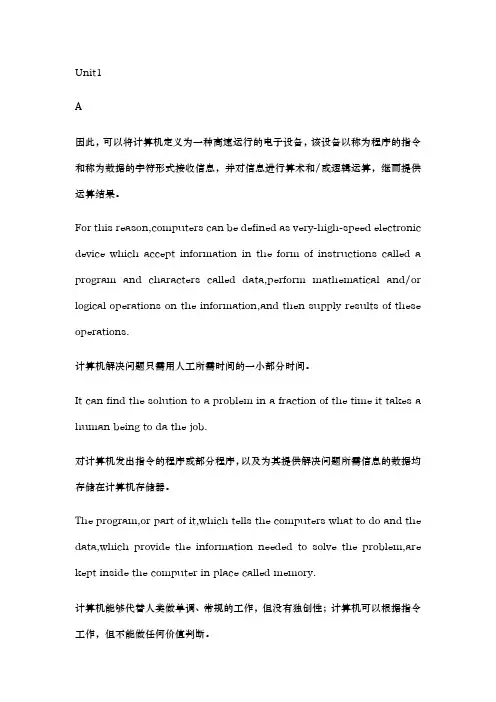
Unit1A因此,可以将计算机定义为一种高速运行的电子设备,该设备以称为程序的指令和称为数据的字符形式接收信息,并对信息进行算术和/或逻辑运算,继而提供运算结果。
For this reason,computers can be defined as very-high-speed electronic device which accept information in the form of instructions called a program and characters called data,perform mathematical and/or logical operations on the information,and then supply results of these operations.计算机解决问题只需用人工所需时间的一小部分时间。
It can find the solution to a problem in a fraction of the time it takes a human being to da the job.对计算机发出指令的程序或部分程序,以及为其提供解决问题所需信息的数据均存储在计算机存储器。
The program,or part of it,which tells the computers what to do and the data,which provide the information needed to solve the problem,are kept inside the computer in place called memory.计算机能够代替人类做单调、常规的工作,但没有独创性;计算机可以根据指令工作,但不能做任何价值判断。
A computer can replace people in dull,routine tasks,but it has no originality;it works according to the instructions given to it and cannot exercise any value judgments.如果操作者不给予指示,也不提供适当信息,计算机就什么也做不了;但由于电脉冲能以光速运行,因此计算机几乎瞬间便能处理大量算术逻辑运算。
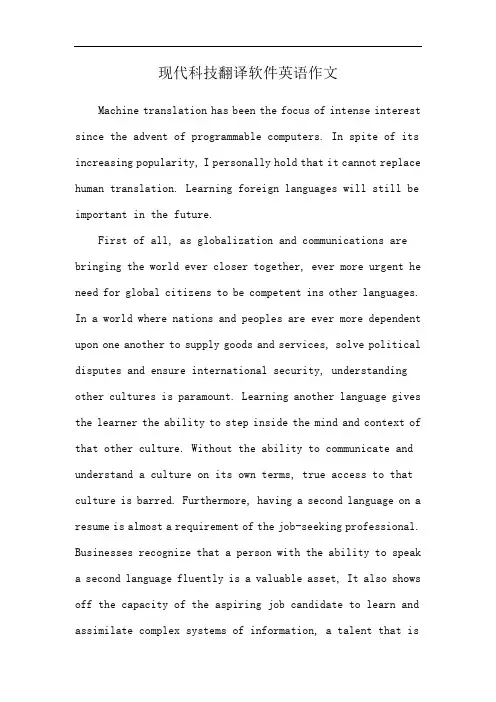
现代科技翻译软件英语作文Machine translation has been the focus of intense interest since the advent of programmable computers. In spite of its increasing popularity, I personally hold that it cannot replace human translation. Learning foreign languages will still be important in the future.First of all, as globalization and communications are bringing the world ever closer together, ever more urgent he need for global citizens to be competent ins other languages. In a world where nations and peoples are ever more dependent upon one another to supply goods and services, solve political disputes and ensure international security, understanding other cultures is paramount. Learning another language gives the learner the ability to step inside the mind and context of that other culture. Without the ability to communicate and understand a culture on its own terms, true access to that culture is barred. Furthermore, having a second language on a resume is almost a requirement of the job-seeking professional. Businesses recognize that a person with the ability to speak a second language fluently is a valuable asset, It also shows off the capacity of the aspiring job candidate to learn and assimilate complex systems of information, a talent that issure to catch the attention of any human resources department: Though computers can translate different kinds of languages, machine translation has many shortcomings, making it impossible for it to replace human translation. Computer translation is understandable, but not of publishable quality. Furthermore, the computer cannot discern context and intended meaning the same way a human can. On the contrary, human translation is more accurate and reliable.In conclusion, computer translation cannot replace human translation and learning foreign languages will remain vital in the future.。

生活中新的技术:
众所周知,如今科技的发展给我们的日常生活带来极大的便利,那么到底有哪些便利呢?
手机通信让我们在哪都能和朋友聊天。看书已经不是非得在纸质书上,还能在电子书上。手
提式的电脑越做越薄,让我们在户外也能轻松上网。当然这些便利来自于先进的技术。比如
超高的屏幕像素让我们体验更清晰的影像。更快的处理器使得我们的手机或电脑用起来更流
畅。优秀的音质处理让我们享受音乐的美妙。当然还有更多的先进产品使得我们在生活中能
更加享受。
所以最后感谢我们都生活在这个时代。
对本专业的认识:
我大学所学的专业是电子科学与技术,这个专业主要是学习光与电,然后将这两个东西联系
起来。
光知识方面就是传统的光学知识,然后进而将光应用在通信方面,例如光纤通信,光纤传感
等。那么,电知识方面就是将电路方面的东西设计成生活中能够起到作用的东西,比如收音
机,我们将设计成的电路在板子上画出来然后将元器件安装在上面,基本上一个产品就做出
来了。
那么最后就是将电与光应用起来,比如光纤传导过程中需要调制,而调制的工具就是电。以
上就是我对所学专业的认识。
自己以后的规划:
我所学的专业是电子科学专业,我希望将来能够从事这个专业的工作。
这个专业所对应的工作是电子设计工程师或者光通信研发,那我比较喜欢电子的专业,因为
我本身是一名电子爱好者,对于电子设计比较感兴趣。我希望能够到那些知名的电子公司去
工作。与我的小伙伴们一起研发电子产品,希望未来能让人们用上我设计的产品。当然一切
都需要努力。我距离我的目标还很远。
最后当然希望未来将会更好。
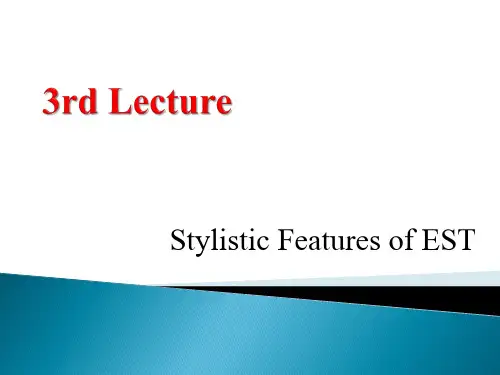
Unit 1 EnvironmentEarth’s Health in Sharp Decline, Massive Study Finds大规模研究发现:地球的“健康”每况愈下The report card has arrived from the largest ever scientific Earth analysis, and many of the planet’s ecosystems are simply not making the grade.有史以来对地球进行的最大规模的科学分析结果表明,地球上的许多生态系统都达不到标准。
The UN-backed Millennium Ecosystem Assessment Synthesis Report found that nearly two-thirds of Earth’s life-supporting ecosystems, including clean water, pure air, and stable climate, are being degraded by unsustainable use.由联合国主持的《千年生态系统评估综合报告》指出,由于不可持续的使用,地球上将近三分之二的用来维持生命的生态系统(包括干净的水源、纯净的空气以及稳定的气候)正遭受破坏。
Human has caused much of this damage during the past half century. Soaring demand for food, fresh water, timber, fiber and fuel have led to dramatic environmental changes, from deforestation to chemical pollution, the report says. The already grim situation may worsen dramatically during the first half of the 21st century, the report’s authors warn.以上大部分的破坏都是人类在过去的半个世纪里造成的。
科技英语写作与翻译一、科技论文1.科技论文科技论文是论述自然科学和技术开发创新取得的成果说明文章。
是运用概念、判断、推理、证明或反驳等逻辑思维手段分析表达自然科学理论和技术开发研究中所获取的成果。
按写作目的来说,有学术论文和学位论文。
就研究课题和性质而言,有基础理论研究、实验研究、开发应用研究等所获成果的研究论文。
学术论文是论述创造性研究工作成果的书面文件,或者是有些试验性、观测性的新知识的科学客观实际记录,或者是应用已知的科学理论或原理在技术研究开发中应用而取得新进展的总结报告。
学位论文是用以申请授予相应的学位(学士论文、硕士论文、博士论文)或者某种学生资格而提出作为考核及评审的文件。
其表明作者本人从事创造性科学研究而取得的成果及独立从事具有新发现的科研工作的能力。
通过论文反映学位申请者所具有的学识水平、工作能力。
无论哪种类型的论文在写作格式上基本相同,必须具备鲜明的观点、充分的论据和科学的论证及一些基本要求,有新的科技信息,有一定的学术价值,有事实为依据,有可读性。
科技论文在表达上,语言要明确、简洁,条理层次分明,图解形象,论证严谨、客观、通顺、准确。
不需要冗长的描述与华丽的修饰,只需要以论点为核心,以材料为佐证论述要表达的问题,有的放矢,实事求是。
科技论文的质量要求:(1)论文课题的目的要求要明确,对其重要性的论证,观点要明确,选题要确切反映科研工作,在工作理论和生产实际中有一定的价值;(2)在课题范围内,系统地查阅国内外文献,了解有关科研信息。
对前人的主要研究成果及复杂网络要全面了解,综述精炼完善,理解、分析、评论资料要有自己的见解,指出解决问题的可能性与途径,并提出方案;(3)对本课题的实验方案、研究方法要进行充分论证,所采用的实验方案、研究方法要合理设计,要严密、系统、完整。
对所获得的结果、理论要进行分析和对比,看其是否充分、真实、合理、可靠。
原始资料齐全,数据处理合理,对已有的资料运用正确恰当、推理正确、计算无误;(4)结论正确有说服力,有充分的科学依据,体现作者的见解和在研究工作中所解决的问题;(5)论文在理论分析、计算方法上具有新的见解,在试验设计技术、设备、工艺方法方面有所改进;(6)文章结构清楚,文字通顺简练,论述准确、清晰、规范、逻辑性强,图表设计要精确美观。